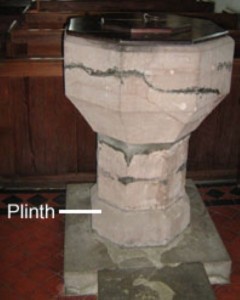On entering St. David’s church in Heyope the combination of light and pleasing proportion give an atmosphere of quiet dignity.
(Click a link or scroll down the page to see details.)
Screen
Roof
Font
Memorial
Pulpit & lectern
Bells
Tiles
Piscina & sedilla
String course
Windows
Organ
Two chairs
Needlework
Screen
Fifteenth Century Screen: The focal point of St David’s Church is its fifteenth century oak screen. It was described by Sir Stephen Glynne in the nineteenth century as “a fair wood screen of Perpendicular character.”
It has been carefully restored, but its rather worn appearance lends it a mellow charm.

It consists of five bays either side of a triangular headed entrance. The bays are divided by ogee moulded mullions and have vertical tracery in their heads.
The headbeam is moulded with rounds, hollows and ogees.
[maxgallery id=”7509″]
The spandrels either side of the doorhead are carved with trefoils in circles. The doorhead and the rood (the cross) which surmounts it are not original.
The plain middle rail on the left side of the screen entrance is scratched with the initials R.W. and the name R.I. Williams.
[maxgallery id=”7515″]
Back to top
Roof
The Victorian pitch pine roof is fifteenth century in style. Its principal trusses have arch braced collars with cusped raking struts.
[maxgallery id=”7519″]
Font
An octagonal sided font, probably fourteenth century, stands close to the south entrance. It rests upon its original stem and base, but its stone plinth and wooden cover are more recent.

Back to top
Memorial
On the south wall is a 1796 touching memorial to an eleven-year-old boy and his siblings. It is painted on wood.

Back to top
Pulpit and Lectern
The Victorian pulpit is enriched with carving, reflecting the tracery in the screen.
The lectern or ‘Reading Desk’ with its ‘Perpendicular’ traceried panels, was given by Mr Evans, a Heyope Schoolmaster when he retired, around 1930.
[maxgallery id=”7521″]
Bells
Opposite the south entrance rests a redundant bell, now cracked, dating from the 14th century and comes from the workshop of John Martin of Worcester. Around the top in Lombardic capitals is the inscription:
(St Andrew, pray for us).
Heyope has two of only thirteen medieval bells in all of Radnorshire.
The two bells still in the bell tower are inscribed:
STA MA . . . PRO NBS [About 1330]
(Sancta Maria {Holy Mary}; pray for us)
SOLI DEO GLORA PAX HOMINIBUS [1670]
(To God alone glory and peace to men)

Back to top
Tiles
Piscina and Sedilia
String Course
Windows
Organ
Two Chairs
Needlwork
[maxgallery id=”7523″]




